Week 6 Forum - Physical Computing I
The most frustrating part of this weeks pract was trying to find the right resistors. I am colorblind so it's near impossible for me to differentiate the rings. They all look the same to me.
Something else that was annoying was the fact that the sound wouldn't upload with the movies on youtube. I have placed the audio tracks underneath instead.
Exercise 1 - Stage 1 - Light Up LED
I couldn't finish this exercise because I don't have any LEDs (due to thieves). This is as far as I could go.
Exercise 1 - Stage 2 - Turn On A Square Wave Generator
[16.4MB]
Exercise 1 (Stage 2) [620KB]
Exercise 2 - Stage 1 - Use A Switch To Trigger A Note
[6.8MB]
Exercise 2 (Stage 1) [432KB]
Exercise 2 - Stage 2 - Use A Square Wave To Trigger A Note
AUDIO
Exercise 2 (Stage 2) [359KB]
Exercise 3 - Stage 1 - Send Control Data Using A Potentiometer
[7.7MB]
Exercise 3 (Stage 1) [496KB]
Exercise 3 - Stage 2 - Send Control Data Using an LDR
Big suprise, I don't have an LDR because some &$*@!# stole it from my kit. Well at least I didn't have to do the exercise.
[1] Christian Haines. "Music Technology Forum: Semester 2 - Week 6 - Physical Computing I". Lecture presented at the Electronic Music Unit, University of Adelaide, South Australia, 30th August 2007.
Monday, August 27, 2007
Friday, August 24, 2007
Week 5 Forum - Circuit Bending II
In the previous weeks I have done okay and managed to get some sort of result. This week was the first time where I basically wasted hours on end. So, after a very unproductive weekend all I have to show for it are some broken toys and circuits that never worked. At least the pictures look good. I was considering making my own noise and square waves and posting it as the toys' sound. Do you think anyone could tell the diff?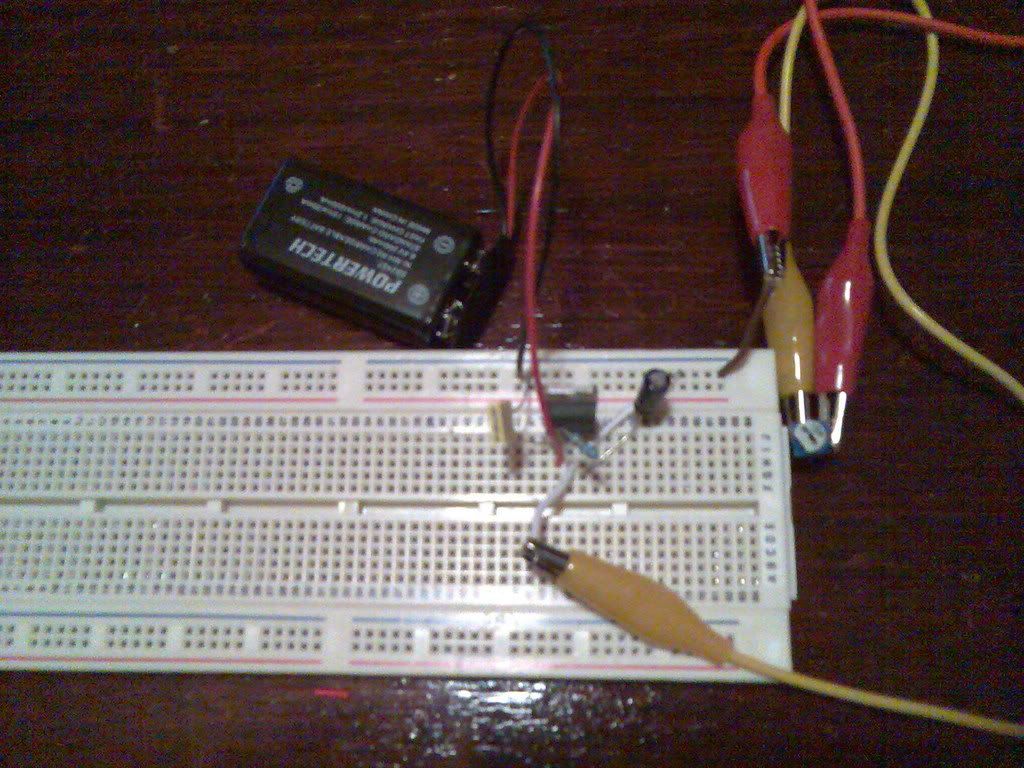



I broke the fart machine not happy!
My wasted mess. . .
Sound File
Circuit Bending Audio [439KB]
[1] Christian Haines. "Music Technology Forum: Semester 2 - Week 5 - Circuit Bending II". Lecture presented at the Electronic Music Unit, University of Adelaide, South Australia, 23rd August 2007.
Tuesday, August 14, 2007
Week 4 Forum - Circuit Bending I
This week our task was to circuit bend our own toy. I was all set and went down to the reject shop in town and bought my toy.
The I opened it and was very "annoyed!" (university blog language)
Turns out there wasn't any chip inside of the gun even though the front claimed it had a light near the trigger. I obviously had to go back to the shops and I couldn't find anything. Before almost giving up I did find this. . .
[6.2MB]
I then proceeded to take this toy apart to explore what was inside.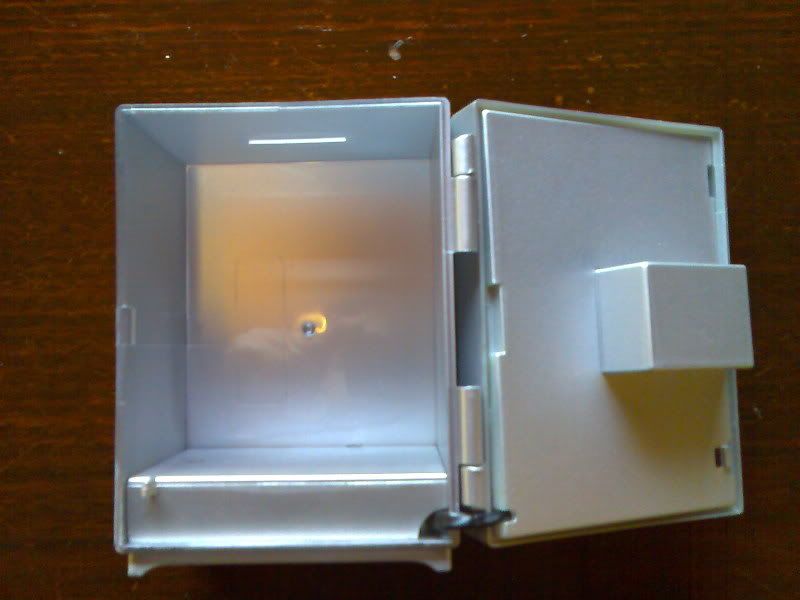


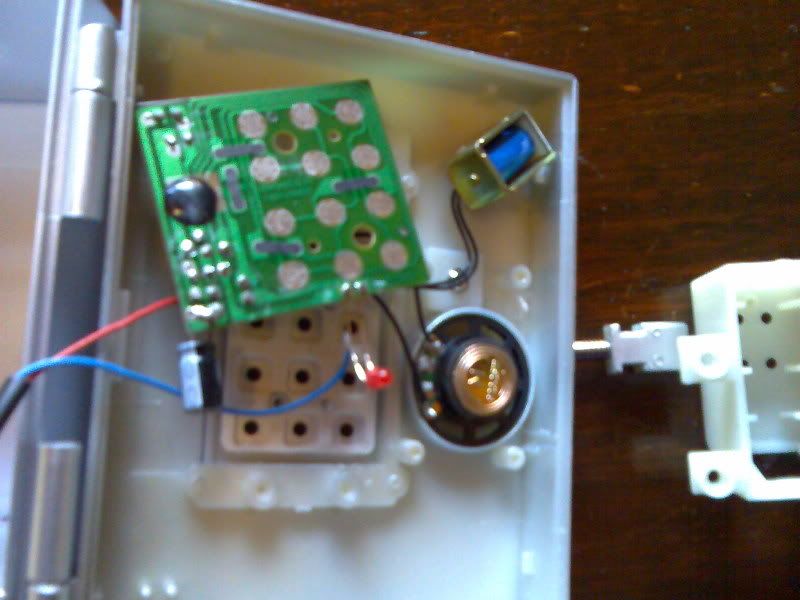



After I completely stuffed it up. . .
[41.7MB]
Just so you know this stank! I could smell burning plastic and the foil was getting heaps hot! I definitely shorted the circuit!
Sound File
Circuit Hacking [484KB]
[1] Christian Haines. "Music Technology Forum: Semester 2 - Week 4 - Circuit Bending I". Lecture presented at the Electronic Music Unit, University of Adelaide, South Australia, 16th August 2007.
CC2 Week 4 - Synthesis I - Additive Tremolo RM & AM
[1]
When I listen to my patch this is what I see. . . 


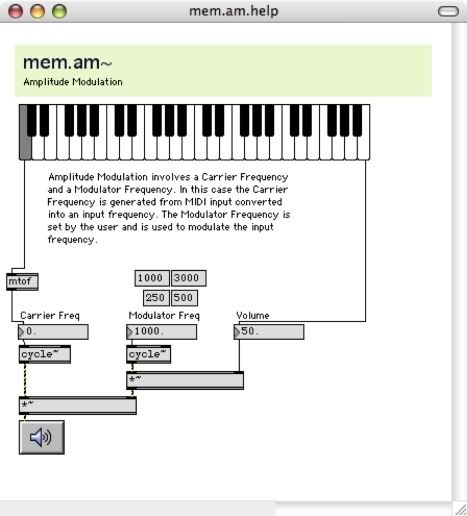


Max Patches
Patch + Max Objects
Sonic Result
[1] wikipedia, 'Additive synthesis'. http://en.wikipedia.org/wiki/Additive_synthesis (Accessed 2/9/7)
[2] Christian Haines. "Creative Computing Lecture - Semester 2 - Week 4 - Synthesis I - Additive, Tremolo, RM & AM". Lecture presented at the Electronic Music Unit, University of Adelaide, South Australia, 16th August 2007.
AA2 Week 4 - Game Engine Overview [1]
[1]
As you know, my post-2000 game I am analyzing is Unreal Tournament. This being the original version which I find more fun than the 2004 release. The upcoming 2007 release looks to be good on the trailer but I obviously haven't played it yet. [3]
[2]
Unreal Tournament 2007 looks like a cool game
There is a point for all this rambling. That is since all the Unreal releases are based on the Unreal Engine licenced by Epic Games. This engine was first released in the game Unreal in 1998. The engine has had subsequent versions for each release of Unreal Tournament
The original engine that was used for Unreal was also used for Unreal Tourament. Unreal Tournament was released between the end of 1999 or beginning of 2000 (depending on which country you live in).
Unreal and Unreal Tournament have been the basis for games with similar characteristics:
Tom Clancy's Rainbow Six 3: Raven Shield
Tom Clancy's Rainbow Six: Vegas
Red Steel
Gears of War
Since then the engine has also been used for future games including:
* Adventure Pinball: Forgotten Island — (2001) Digital Extremes
* Brother Bear — (2003) KnowWonder Digital Mediaworks
* Clive Barker's Undying — (2001) Dreamworks Interactive
* Deus Ex — (2000) Ion Storm
* Deus Ex: The Conspiracy — (2002) Ion Storm
* Dr. Brain's Thinking Games: Action/Reaction — (1999) Knowledge Adventure
* Harry Potter and the Chamber of Secrets — (2002) KnowWonder Digital Mediaworks
* Harry Potter and the Philosopher's Stone (Harry Potter and the Sorcerer's Stone in the U.S) — (2001) KnowWonder Digital Mediaworks
* Mobile Forces — (2002) Rage Software
* Nerf Arena Blast — (1999) Visionary Media, Inc.
* New Legends — (2002) Infinite Machine
* Rune — (2000) Human Head Studios
* Rune: Halls of Valhalla — (2001) Human Head Studios
* Rune: Viking Warlord — (2001) Human Head Studios
* Star Trek: Deep Space Nine: The Fallen — (2000) The Collective
* Star Trek: The Next Generation: Klingon Honor Guard — (1998) MicroProse
* Tactical Ops: Assault on Terror — (2002) Kamehan Studios
* TNN Outdoors Pro Hunter — (1998) DreamForge Intertainment
* Twin Caliber — (2003) Rage Software
* Unreal — (1998) Epic Games
* Unreal Mission Pack: Return to Na Pali — (1999) Legend Entertainment
* Unreal Tournament — (1999) Epic Games
* Unrealty — (2000) Perilith Industrielle
* Virtual Reality Notre Dame: A Real Time Construction — (1999) Digitalo Studios
* The Wheel of Time — (1999) Legend Entertainment
* X-COM: Enforcer — (2001) MicroProse [4]
[4]
A comparison of Unreal Engine 1, 2 and 3's rendering capabilities using the Malcolm model from Unreal Tournament, Unreal Tournament 2004 and Unreal Tournament 3 side-by-side. As you can see, the graphic capabilities have come a long way.
There are three versions of the Unreal Engine but the game I am focusing on utilizes the first Unreal Engine. In terms of finding information on the Audio Engine for Unreal Tournament, it was actually quite hard to find anything at all. I did find an article written by Tim Sweeney, a programmer who worked on the Unreal Engine. He also founded Epic Games.
Digital Sound System
* Supports 3D positioning via distance attenuation, stereo panning, doppler shifting.
* Supports software Dolby Surround sound encoding for full 360-degree panning among the center, rear, left, and right channels (requires a Dolby decoder).
* Supports rich, ambient environmental sounds which can be fully controlled from UnrealScript.
* Advanced software mixer supports up to 64 stereo channels of music and sound, and mixes to a 32-bit buffer internally for maximum sound quality.
* Supports 8- and 16-bit samples using any playback rate from 4 kHz to 44 kHz.
* Dynamic sample interpolation enables high-quality pitch shifting without distortion.
* Optimized to take advantage of Intel's MMX™ technology, with fallback to support regular Pentium® processors.
* Supports DSP-style reverb and echo postprocessing on the sound effect stream.
* Aural raytracing realistically simulates the echo and reverb characteristics of complex environments. When enabled, UnrealEd pre-computes a reverb kernel for each designer-specified zone in the level.
* Supports Microsoft DirectSound and legacy WinMM sound output for backwards compatibility.
* Plug-in interface makes it possible to integrate other sound systems into the Unreal technology.
* Supports Aureal A3D 3D sound positioning, and the upcoming Creative Labs 3D sound cards.
Digital Music System
* Supports both CD audio and realtime digitally mixed music. Game designers can mix and match soundtracks in both formats to take maximum advantage of the speed and quality of CD music and the dynamic music and Internet portability of digitally mixed music.
* Smooth and instantaneous dynamic music changes for fading between songs, fading between tracks within a song, fading to silence, and instantly switching songs.
* Realtime mixing of musical instruments and sound effects.
* Supports volume and panning envelopes for professional composing.
* Supports up to eight octaves per sample.
* Supports all widely used module file formats, including .mod, .s3m, .xm, and .it. [5]
[1]
NICE!
[1] Absolute-Playstation, 'Unreal Tournament'. http://www.absolute-playstation.com/gp2a/unreal_tournament_hr_1.jpg (Accessed 10/8/7)
[2] youtube, Unreal Tournament 2007 Trailer. www.youtube.com (Accessed 10/8/7)
[3] wikipedia, 'Unreal Tournament'. http://en.wikipedia.org/wiki/Unreal_Tournament (Accessed 10/8/7)
[4] wikipedia, 'Unreal Engine'. http://en.wikipedia.org/wiki/Unreal_Engine (Accessed 10/8/7)
[5] Epic MegaGames, Inc. 'Unreal Technology Features'. http://unreal.epicgames.com/UnrealFeatures.htm (Accessed 10/8/7)
[6] Christian Haines "Audio Arts: Semester 2, Week 4: Game Engine Overview" Lecture presented at the Electronic Music Unit, University of Adelaide, 7th August 2007.
Week 3 Forum - Modular Electronics
This week I tried recording the piezo from last week on some newspaper. I placed the piezo inside the paper and shook it around. The sound created was interesting but I was hoping for a more brighter sound. 
Newspaper Piezo Sound [264KB]
I completed the tasks A, B & C from our forum class. I found that these exercises took a very long time and it was frustrating when something as simple as changing one pin or placing a new resistor or capacitor could make or break the entire circuit.
Square Wave Oscillator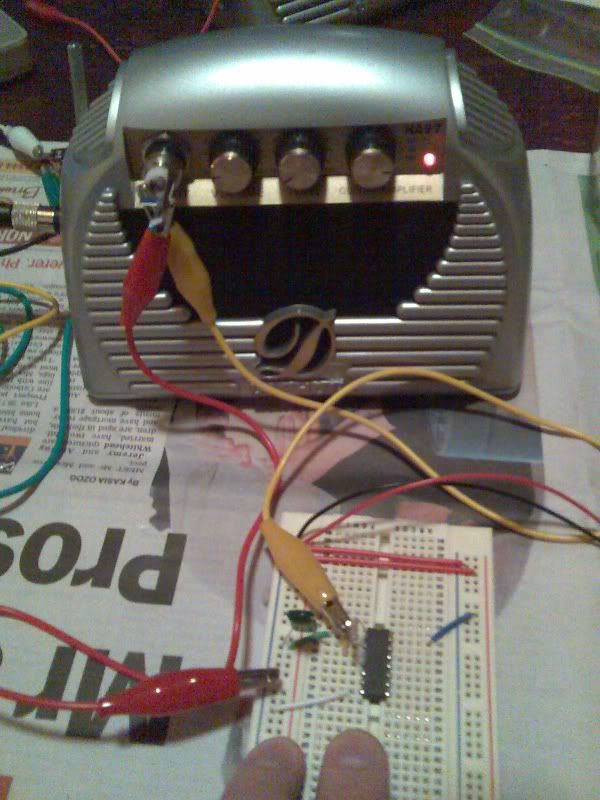
Square Wave Oscillator [1MB]
Modulating A Square Wave Oscillator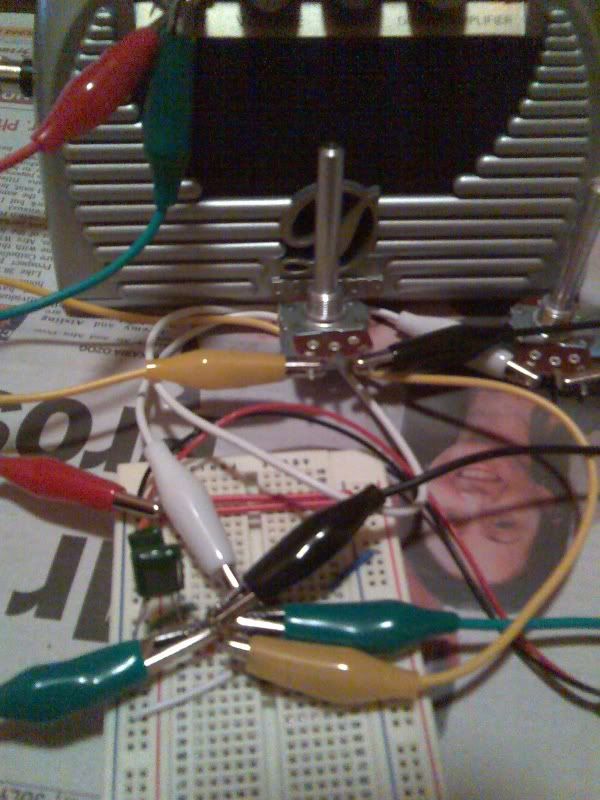
Modulating A Square Wave Oscillator [1MB]
Simple Ring Modulation Effect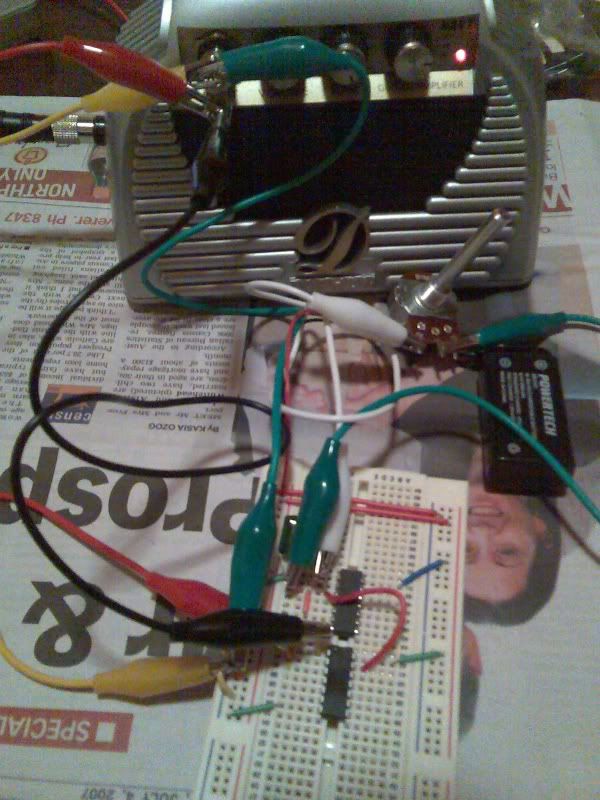
Modulating A Square Wave Oscillator [1.2MB]
me playing around. . .
I did some further experimentation with the piezo. I tried using the piezo as a speaker and then joining it to another piezo which was connected to an amplifier. At times I got small shocks and the piezo was vibrating a lot.
[14.9MB]
you haven't heard Armin van Buuren till you've heard him through a piezo. . .
[10.9MB]
my piezo setup. . .
[8MB]
teapot piezo. . .
[1] Christian Haines. "Music Technology Forum: Semester 2 - Week 3 - Modular Electronics". Lecture presented at the Electronic Music Unit, University of Adelaide, South Australia, 9th August 2007.
Wednesday, August 08, 2007
AA2 Week 3 - Process & Planning
[2]
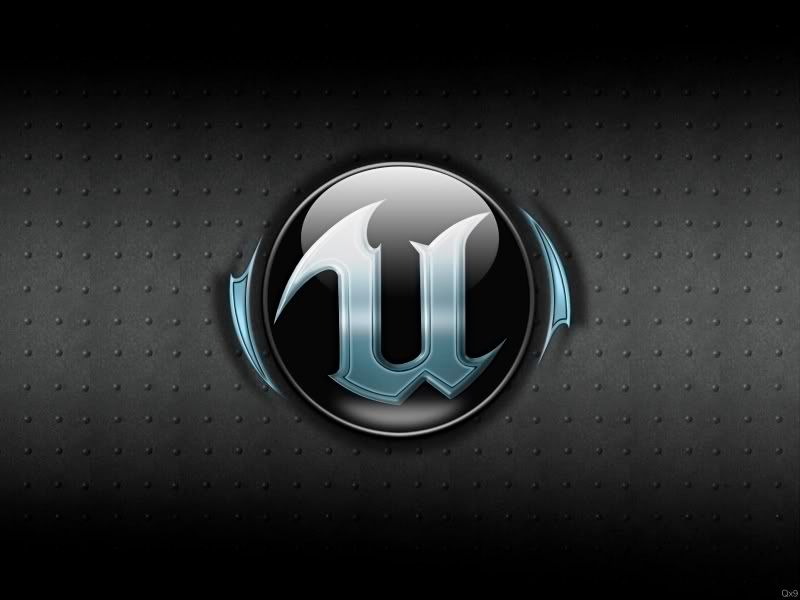
This week I was going to analyse Counter-Strike, the first person shooting game. I have played this many times at those gaming placing in town. I chose not to study this game because all the movies on youtube were pathetic and I couldn't find a demo to play around with. Therefore I decided to analyse Unreal Tournament instead.
[1]
There were so many funny Counter-Strike movies just search youtube. . . [1:06]
Unreal Tournament (UT) is a popular first person shooter game that was released on the 26th November 1999. Yes I know we were meant to research a post-2000 game but I figured 39 days was enough leeway. The game has since had multiply updates and releases. The most recent version Unreal Tournament 2007 will be released in November this year.
When analysing the sounds of this game I looked at the weapons and environment sounds first. Then listened to the sounds of picking up objects like weapons, ammo and health. Finally I looked at the menu sounds at the start.[3]
[2]

[2]

[1]
Unreal Tournament in action. . .[1:59]
ASSETS LIST
Assets List [pdf]
Assets List [excel]
[1] youtube, www.youtube.com (Accessed 11/8/7)
[2] UnrealSp.Org, 'The premier Unreal single player site'. http://www.unrealsp.org/gameguide/whatis.html (Accessed 11/8/7)
[3] Christian Haines "Audio Arts: Semester 2, Week 3: Game Audio Analysis" Lecture presented at the Electronic Music Unit, University of Adelaide, 31st July 2007.
Monday, August 06, 2007
Week 2 Forum - Input and Output
I found this weeks soldering frustrating. My lack of patience is not a good mix for what we needed to do. My soldering necklace will be going on eBay in a couple of weeks. You can get in early for a special price of $5!
Get in quick! Offers are coming in like mad!
[1]
Incase you didn't know what soldering was. . .
This weeks exercise was to solder a piezo microphone onto some wire and then solder the other side to a TS connector (jack). The hardest part was stripping the wire plastic cover off the piezo wires. This is because they were so tiny and I kept snipping the wire. Also the wires connected to the actual piezo mic were very fragile and I had to resolder them back on a few times.[2]
My piezo. . .
I ended up plugging the piezo straight into my laptop input and recording the sounds into my computer.
Piezo Recordings
Piezo Sound 1
Piezo Sound 2
Piezo Sound 3
These were recorded on the dining room table. . .
Recording my piezo into Logic. . .
[1] wikipedia. 'Soldering', http://en.wikipedia.org/wiki/Soldering (Accessed 7/8/7)
[2] Christian Haines. "Music Technology Forum: Semester 2 - Week 2 - Input & Output". Lecture presented at the Electronic Music Unit, University of Adelaide, South Australia, 2nd August 2007.
CC2 Week 2 - Signal Switching and Routing



Max Patches
Patch + Max Objects
[1] Christian Haines. "Creative Computing Lecture - Semester 2 - Week 2 - Signal Switching and Routing". Lecture presented at the Electronic Music Unit, University of Adelaide, South Australia, 2nd August 2007.
Wednesday, August 01, 2007
AA2 Week 2 - Game Audio Analysis
Donkey Kong Country (1994)
[1]
SNES - Audio quick reference
Processors Sony SPC700, Sony DSP
Clock Input: 24.576 MHz
Rates SPC700: 1.024 MHz
Format 16-bit ADPCM, 8 channels
Output 32 kHz 16-bit stereo
Effects
* ADSR envelope control
* Frequency scaling and modulation using Gaussian interpolation
* Echo: 8-tap FIR filter, with up to 0.24s delay
* Noise generation
The SFX are of decent quality on the SNES. The audio quality is 16-bit with 8 channels. There is the typical noise generator for basic effects and a frequency generator with an envelope to shape the sounds.
The music varies according to different worlds. Each world has some levels that use the same music. E.g. all water levels use the same music and there is a water level in each world.
There is a new soundtrack for the first level in each world and it acts as a signature sound for that world.
The seven worlds are:
Kongo Jungle
Monkey Mines
Vine Valley
Gorilla Glacier
Kremkroc Industries Inc.
Chimp Caverns
Gangplank Galleon[1][2]
[3]
[4]
[4]
The music for this game was so popular that it was released on a CD. This was probably a first for that time. Even when compared to games in the last few years, the soundtrack is of superior quality.[5]
[5]
Quite possibly the best CD ever released. . .
The graphics were also revolutionary because it was the first home console to use pre-rendered 3D graphics. I remember when the game first came out there was talk of the first “3D Game”. I was quite young at the time so I didn’t really know whether the hype was justified. Still, I can say with confidence now that this game is a classic and will be for some time.[1][7]
[6]
The first level. . .
[1] wikipedia. 'Donkey Kong Country', http://en.wikipedia.org/wiki/Donkey_Kong_Country (Accessed 6/8/7)
[2] wikipedia. 'Super Nintendo Entertainment System', http://en.wikipedia.org/wiki/Super_Nintendo_Entertainment_System (Accessed 6/8/7)
[3] vgmuseum. 'Donkey Kong Country', http://www.vgmuseum.com/reviews/snes/dkc/ (Accessed 6/8/7)
[4] consolepassion. 'Donkey Country Country', http://www.consolepassion.co.uk/review-donkey-kong-country.htm (Accessed 6/8/7)
[5] wikipedia. 'DK Jamz', http://en.wikipedia.org/wiki/DK_Jamz (Accessed 6/8/7)
[6] youtube. 'Donkey Kong Country Level 1', http://www.youtube.com/watch?v=IuN9k1qCnRA (Accessed 6/8/7)
[7] Christian Haines "Audio Arts: Semester 2, Week 2: Game Audio Analysis" Lecture presented at the Electronic Music Unit, University of Adelaide, 31st July 2007.
